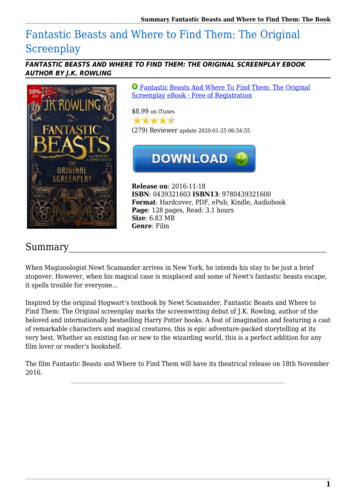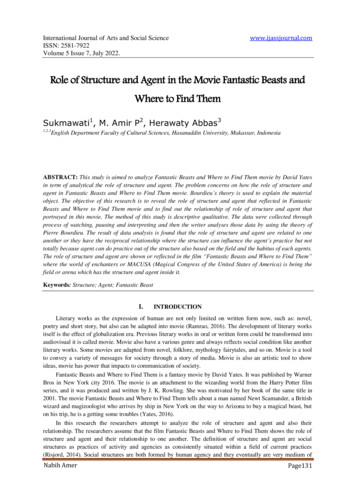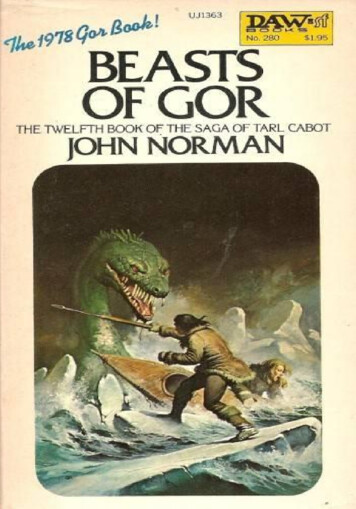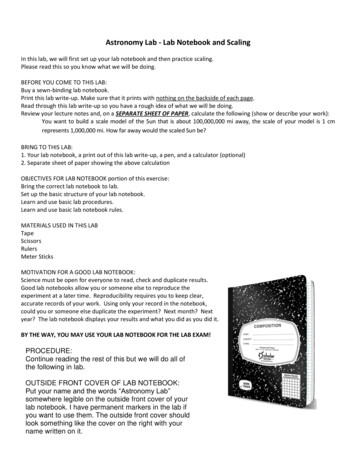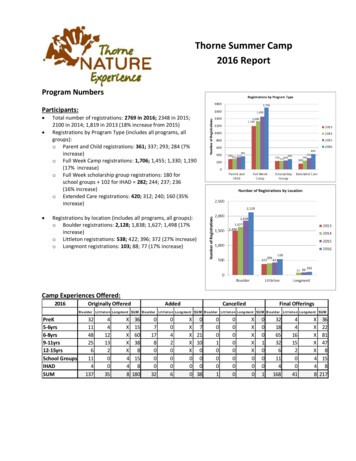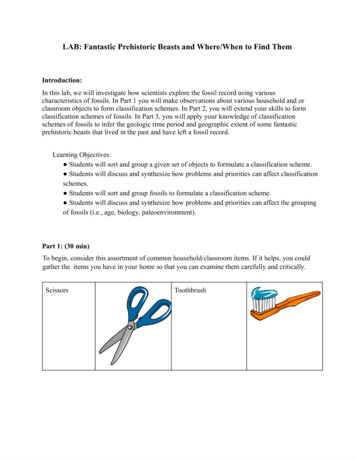
Transcription
LAB: Fantastic Prehistoric Beasts and Where/When to Find ThemIntroduction:In this lab, we will investigate how scientists explore the fossil record using variouscharacteristics of fossils. In Part 1 you will make observations about various household and orclassroom objects to form classification schemes. In Part 2, you will extend your skills to formclassification schemes of fossils. In Part 3, you will apply your knowledge of classificationschemes of fossils to infer the geologic time period and geographic extent of some fantasticprehistoric beasts that lived in the past and have left a fossil record.Learning Objectives: Students will sort and group a given set of objects to formulate a classification scheme. Students will discuss and synthesize how problems and priorities can affect classificationschemes. Students will sort and group fossils to formulate a classification scheme. Students will discuss and synthesize how problems and priorities can affect the groupingof fossils (i.e., age, biology, paleoenvironment).Part 1: (30 min)To begin, consider this assortment of common household/classroom items. If it helps, you couldgather the items you have in your home so that you can examine them carefully and critically.ScissorsToothbrush
KnifeBox of FlossStaplerCell phoneBowlSockMugBookCD casePaperclip
PenBlue Ray DVD CaseYour only task over the next 10-15 minutes is to group these items into categories that makesense to you. You may group them in any way you choose, but you must have a minimum of 3groups and will need to defend your classification scheme. Be creative in how you sort youritems and use any criteria that you think are meaningful. You may put them into any number ofgroups you would like, but everything must belong to a group, and every group must have clearcriteria for how you put it together. Be prepared to explain your decisions.1. When you have finished sorting your items into categories, post them on the (discussion)board, but do not provide any information about the justification for your classificationstrategy yet. Your initial post could look something like this.Group 1Group 2Group 3Item AItem BItem QItem JItem CItem ZItem WItem DItem S2. Next, take a look at what some of the other groups did and respond to their post. Based onthe groups they formed, what characteristics of the objects do you think they wereconsidering?3. After considering your classmates’ responses, answer the following questions in a reply toyour initial discussion board post. First, explain your classification scheme. Then answer the following questions: Whydid you choose your particular classification scheme? Is there a “right” answer whenclassifying these objects?
How would you rearrange your classification scheme to investigate each of thesequestions: What time period (i.e. year, decade, century) were you likely in? What location (i.e. part of the house/school) were you likely in? What activity were you likely doing?Part 2: (45 minutes)In this part of the lab, you will complete the same steps as above, except this time you’ll beworking with the fossil models available in the Digital Atlas Virtual Collection provided in pdfformat. You should use the information provided in the sources provided with your Digital AtlasVirtual Collection handout to sort these fossils into categories. As before, use any criteria youthink may be meaningful. Be prepared to justify your classification scheme.1. When you have finished sorting the fossils into categories, post them on the (discussion)board, but do not provide any information about the justification for your classificationstrategy yet. Your initial post could look something like this.Group 1Group 2Group 3Fossil AFossil BFossil QFossil JFossil CFossil ZFossil WFossil DFossil S2. Next, take a look at what some of the other groups did and respond to their post. Based onthe groups they formed, what characteristics of the objects do you think they wereconsidering?3. After considering your classmates’ responses, answer the following questions in a reply toyour initial (discussion board) post: First, explain your classification scheme. Then answer the following questions: Whydid you choose your particular classification scheme? Is there a “right” answer whenclassifying these objects? What points did classmates raise that you hadn’t considered when classifying thesefossils? Did your classifications change when you incorporated these newperspectives? How would you rearrange your classification scheme to answer each of thesequestions as if you were the animal which became fossilized:
What geologic time period were you in? What part of the world were you in? What type of environment were you in?Part 3: (60 minutes)Now that you have thought about generating classification schemes, you will need to apply thisknowledge to take a closer look at the fossils in part 2.The PBDB (PaleoBiology DataBase) is a huge online database cataloging fossils throughoutgeologic time. The database has a number of different portals or apps to access different types ofdata. The simplest way to view data on a collection of organisms through time is through theNavigator.From www.paleobiodb.org, click on “Revealing the History of Life” in the center of the pageand you will be taken to the Navigator webpage. To get started, click on the small blue box“Go to Application” in the center of the page under the three large blue box examples.There are 3 main parts in Navigator:1. A map showing continents with dots showing fossil occurrences. The color of the dotsmatches the colors of the geologic timeline displayed across the bottom of the screen. Click ona dot to view information on fossils found at that site.2. The Geologic Timeline across the bottom of the screen showing the major eras, periods andstages. Clicking on a period in the timeline shifts the map above to show fossil collections fromthat time period only. There is an indicator in the top left corner of the map showing the filtersbeing applied to the map. You can unclick the filter there to shift back to showing all fossils fromthe entire timeline on the map. Double clicking on a period in the timeline will expand thatperiod, showing subperiods. Double click on a higher order time unit in the timeline to zoomback out to the entire timeline.3. On the left-hand side of the screen is the toolbar, showing tools you can use to explore thedatabase. The continents icon (just below and – zoom icons) will show continentalreconstructions if you are on a fine enough temporal resolution (i.e., just in the Jurassic period).The bug icon below allows you to search for a specific clade.[clad /klād/ nounBIOLOGY1. a group of organisms believed to have evolved from a common ancestor, and all its linealdescendants."the great ape and human clade"of organism (i.e., cetaceae for whales). The graph icon creates diversity curves (just for theselected taxa/time intervals and continent(s) or that are visible on the map view, so make sureyou haven’t zoomed in or doubled up!). From here you can download the curve or the data in anexcel file. The last icon is the “hand” which shows fun examples to look at.For each fossil use the Paleobiology Database (PBDB), generate a biodiversity curve like the one
on the next page. To make a Biodiversity Chart:1) Search for the taxa in the search bar (top right), e.g., “Blastoidea”. MAKE SURE you clickon the taxa or hit enter. Also check that there are not multiple searches or other filters turnedon (bottom left), especially if you do the searches in succession! To turn off previous filters,just click the “x” on the filter.2) Click on the “toggle stats” button (i.e., the graph icon) to create a diversity curve.A video of Instructions for generating this biodiversity plots can be found here:https://www.youtube.com/watch?v n FkX4Vf 8INote: The website has been updated and the explorer icon is no longer on thefront page. You must click “Revealing the History of Life” to see the Navigatormap.
Example: PBDB Diversity curve for BlastoideaUsing the information from the biodiversity curves, fill in the graph provided, indicating thetemporal range for each of the fossils provided. For example, for the curve provided above(Blastoidea), you would shade in the temporal range of S to P on the chart provided.Use the data you collect to answer the following questions. Submit your answers via thediscussion board.1. You have been given two fossil-bearing rocks. One of them has an ammonite in it. What aresome taxa you could find in the other rock that would let you know: The second rock was older than the one with the ammonite in it. The second rock was younger than the one with the ammonite in it. The second rock was the same age but came from a different environment.2. Suppose you already knew that a fossil-bearing rock was Paleozoic in age. Are there fossilsyou could find in the rock that would NOT help you narrow down its age further?3. Suppose you already knew that a fossil-bearing rock was Mesozoic in age. Are there fossilsyou could find in the rock that would NOT help you narrow down its age further?4. All corals belong to the class Anthozoa. The two different specimens you looked at belong to
different orders within that class (i.e., Tabulata and Scleractinia).a. How does the temporal range of each order compare to the temporal range of theentire class?b. Briefly explain why being able to identify fossils to more precise taxonomiclevels (for example, being able to identify species instead of just classes andorders) might help geologists to create a more precise geologic time scale.5. In which time periods would you expect to find fossil evidence of the TyrannosaurusRex, a fantastical beast featured in the movie “Jurassic Park”?6. Why do you think there are so many more fossils of marine species than terrestrialspecies in this database?7. Provide a paragraph explaining how Part 1 and 2 of this activity helped you tounderstand how classification of fossils found in the PBDB was developed and whetherthis was useful to you in inferring time/place information from those fossils.
LAB: Fantastic Prehistoric Beasts and Where/When to Find Them Introduction: In this lab, we will investigate how scientists explore the fossil record using various characteristics of fossils. In Part 1 you will make observations about various household and or classroom objects to form classification schemes.
